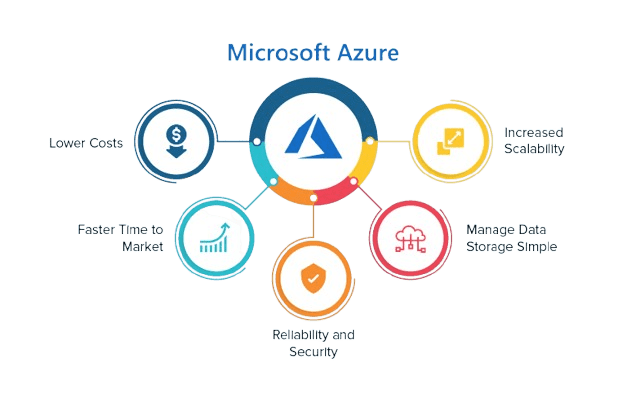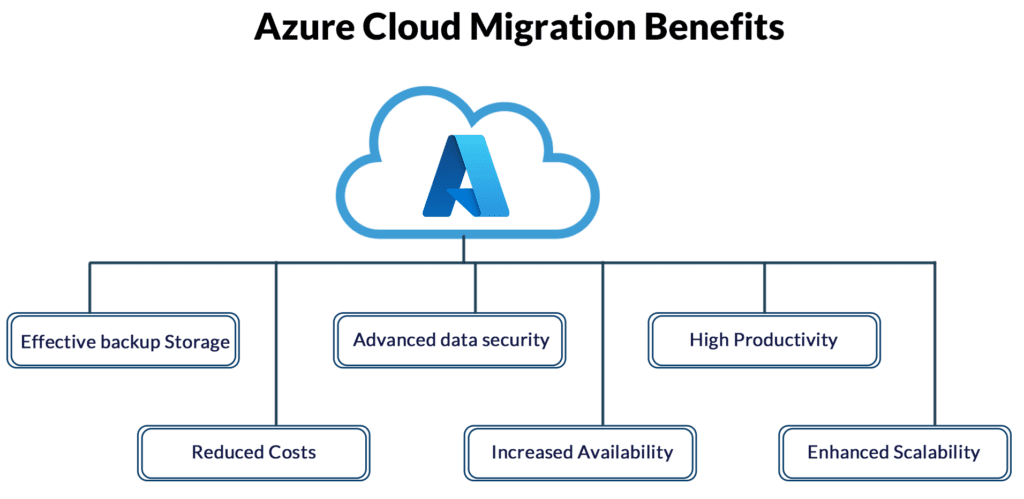
- What is Cloud Migration?
- What is Azure?
- What is Azure Migrate?
- Azure Migration Process
- Azure Migration Tools
- Azure Synapse Pathway
- Azure App Service Migration Assistant
- Azure Storage Migration
- Azure Kubernetes Service (AKS) Migration
- Conclusion
What is Cloud Migration?
The system of shifting information, offerings, and different commercial enterprise additives to cloud computing surroundings improves scalability and performance while additionally supporting slicing the company’s IT expenses. It enables businesses to enhance flexibility, streamline operations, and ensure high availability by leveraging cloud-based infrastructure. Cloud migration also enhances data security, disaster recovery, and compliance while reducing the burden of managing on-premises hardware. Additionally, it enables organizations to adopt AI, machine learning, and big data analytics, driving innovation and agility. With on-demand scalability, businesses can optimize performance and enhance collaboration. AWS Migration Tools like AWS Migration Hub and Database Migration Service, streamline transitions to the cloud. These tools ensure efficient workload management and seamless remote access.Microsoft Azure Training helps teams master cloud solutions, ensuring efficient deployment, security, and innovation. Cloud migration also facilitates automation, reducing manual tasks and operational costs while increasing efficiency. By shifting to a cloud environment, companies gain a competitive edge, improve customer experiences, and future-proof their IT infrastructure against evolving business needs and technological advancements.
What is Azure?
In February 2010, Microsoft launched its Azure cloud computing platform. Simply stated, Microsoft Azure is an agile cloud computing platform that users may utilize to create, administer, and install apps and services through Microsoft information facilities. More than two hundred bodily information facilities run via Microsoft Azure are located worldwide, and each has several linked PC servers.
Here are some key records about Microsoft Azure:
- Flexible – Modify the computing assets as necessary.
- Open- nearly each OS, language, device, or framework is supported.
- Reliable- 99.95% availability SLA (Service-Level agreements) and 24×7 tech support
- Global- Data housed in geosynchronous information facilities
- Economical- pay for what you use
Azure cloud provider is the most pleasant public cloud provider in the marketplace because it’s quick, adaptable, and economical.

What is Azure Migrate?
Microsoft’s Azure Migrate is a device that enables companies to reveal the discovery, evaluation, and migration of on-premises workloads and information to the Azure surroundings with the assistance of a centralized portal. It provides an end-to-end migration solution by assessing infrastructure, databases, applications, and virtual desktops, ensuring a seamless transition to the cloud. Azure Migrate offers built-in tools and integration with third-party solutions, allowing businesses to evaluate cost estimates, performance metrics, and compatibility before migration. It simplifies migration by automating assessments, identifying dependencies, and recommending optimal cloud deployment. Azure Migrate helps modernize IT, reduce downtime, and enhance security. Additionally, AWS Service and Products , like AWS Migration Hub and EC2, support seamless cloud transitions. These tools optimize resources, ensuring efficiency and alignment with business goals. Furthermore, the platform supports phased migration strategies, enabling organizations to move workloads incrementally, minimizing risks, and ensuring business continuity.
Ready to Pursue Your Microsoft Azure Certificate? View The Microsoft Azure Training Offered By ACTE Right Now!
Azure Migration Process
Stage 1: Assess
- You must explicitly define your desires and targets for migration at the preliminary level.
- Next, calculate how a good deal you may keep by moving your on-premises infrastructure to the cloud – Microsoft gives a beneficial calculator that could help you with this.
- You must collect a listing of all of the applications—that is, all of the bodily and digital servers you’re using for your on-premises surroundings for the final step of the Assess section. These statistics may be used to map your servers and locate prerequisites, and dependencies.
- According to your desires and any dependencies, this can assist in deciding which apps emigrate to the cloud first, supplying a sturdy basis for your Azure migration plan.
Stage 2: Migrate
You have to determine your cloud migration method for the second level of the cloud migration process. There are numerous options available:
- .
- Rehost
- Refactor
- Rearchitect
- Rebuild
Stage 3: Optimize
Once you’ve selected a cloud migration method that suits your desires and targets and efficiently moved your on-premises surroundings to Azure, you’re ready to optimize. Everything, including company operations and cloud computing costs, can be optimized.
Stage 4: Secure Manage
The Azure cloud migration process’s very last section is all about safety. Microsoft gives many market-main safety gear and offerings that offer complete visibility into capability safety dangers and advanced cloud safety management. Microsoft gives you all the sources you want to protect your cloud surroundings’ statistics and preserve a watch on its health, from Azure Security Center to Azure Log Analytics, so that you may be assured of its safety and performance.
Excited to Obtaining Your Microsoft Azure Certificate? View The Microsoft Azure Training Offered By ACTE Right Now!
Azure Migration Tools
Azure provides tools to migrate data from on-premises to the cloud based on business needs. Microsoft Azure Training helps teams master migration tools like Azure Migrate and Data Migration Services. It enables efficient planning, execution, and security optimization. With the right skills, businesses can ensure a smooth and successful transition.
Azure MigrateA rapid migration, modernization, and optimization answer for Azure is supplied using Azure Migrate. Discovery, reviews, and appropriate scaling of on-premises infrastructure sources for infrastructure, statistics, and apps are covered within the pre-migration system. Integrating third-birthday birthday celebration answers with Azure Migrate bendy structure might also increase the number of instances covered. It affords those things:
- Range of gear: The Azure Migrate utilities encompass Azure Migrate: Server Migration and Azure Migrate: Discovery and Assessment. Additionally, Azure Migrate interfaces with different Azure gear and offerings in addition to answers from impartial software program vendors (ISVs).
- Unified migration platform: A solo gateway to launch, manage, and display Azure migration.
- Assessment, migration, and modernization: The Azure Migrate hub can be used to assess, migrate, and modernize.
- Servers, databases, and net apps: Web apps and SQL Server times on neighborhood servers can be evaluated and moved to the Azure digital gadget or the Azure VMware answer.
- Web applications: Evaluation and migration of on-premises net apps to Azure App Service and Azure Kubernetes service .
- Databases: Analyze present on-premises SQL Server times and databases and emigrate them to Azure SQL Managed Instances, Azure SQL Databases, or SQL Server on an Azure VM.
- Virtual desktops: Evaluation and migration of on-premises net apps to Azure App Service and Azure Kubernetes Service.
- Data: Utilize Azure Data Box merchandise to unexpectedly and cheaply migrate large quantities of statistics to Azure.

Azure Data Migration Services
On Azure, you need to access some of the PaaS and IaaS alternatives for websites hosting your databases. Azure Data Migration Assistant (DMA) and Azure Database Migration Service (DMS) assist with this system by reading present databases, recommending corrections as necessary, and approving the migration.
What is Azure Data Migration Assistant(DMA)?DMA aids migration by analyzing on-premises SQL instances and determining their compatibility with SQL Server in Azure, Azure SQL Database, or Azure SQL Managed Instances. It conducts a migration assessment to identify potential obstacles and partially supported features that may impact the migration plan. Additionally, Azure information protection ensures data security and compliance throughout the migration process.
What is Azure Database Migration Service(DMS)?After DMA has finished the evaluation, customers can use DMS to migrate workloads from numerous database supply environments to Azure Data platform goal offerings. Migrations can manifest both offline and online. The utility is unavailable even when migrated offline. During the adjustment period to the brand-new surroundings, online downtime is minimal. Because there may be little downtime, online migration is considered a premiere opportunity.DMS now offers online migration of Azure DB for PostgreSQL Single Server Instances to a changed service model, as well as database migration from on-premises and different clouds. The goal surroundings may be either an Azure DB for PostgreSQL Single Server Instance or a Flexible Server.
SQL Server Migration Assistant(SSMA)Customers who use numerous database structures can switch their statistics to SQL Server or Azure Synapse Analytics with SQL Server Migration Assistant (SSMA). The supported supply structures consist of Microsoft Access, MySQL, Oracle, SAP ASE, and DB2 databases.
Azure Synapse Pathway
Porting present SQL code to a brand new platform is one of the foremost demanding situations in upgrading a statistics warehouse. A database might also incorporate hundreds of traces of code written over many years; translating it can be time- and resource-intensive. Azure Synapse Pathway, which makes it feasible to transport present statistics warehouses to Azure Synapse Analytics through computerized code translation, addresses this problem. Data Definition Language (DDL) and Data Manipulation Language (DML) instructions may be mechanically transformed into T-SQL-compliant language using Azure Synapse Pathway, making them well suited with Azure Synapse SQL as a goal for migration. IBM Netezza, Microsoft SQL Server, and Snowflake are supported as supply environments for the service presently in preview.
Exploring Options for a Microsoft Azure Master’s Degree?Enroll For Microsoft Azure Master Course Today!
Azure Backup and Site Recovery- Using Azure Backup, information may be backed up from various sources, including on-premises servers, Azure VMs, controlled discs, Azure report shares, and more. You can use the carrier for information migration by restoring the backup information to the preferred Azure surroundings.
- Azure Backup consists of software consistency for commercial enterprise programs like SQL Server, Exchange, and Share point. Because of this consistency, a feasible environment with the restored information can be deployed without incurring any extra costs.
- Azure site recovery is a cloud-primarily based total catastrophe recuperation technique, which allows information replication from on-premises or other cloud environments to Azure.
- Although the primary purpose of this service is to convert Azure into a disaster recovery website for your workloads, it can also be used to copy workloads and failover setups to Azure.
- To ensure software integrity throughout failover, the carrier also leverages a software-constant snapshot-primarily based totally replication technique.
Azure App Service Migration Assistant
Azure App Service Migration Assistant is a powerful tool designed to help businesses migrate their web applications to Azure App Service with minimal effort and downtime. This tool is particularly beneficial for enterprises running ASP.NET applications on on-premises servers or other cloud environments and looking to move them to Azure for better scalability, security, and cost efficiency. The Migration Assistant performs an automated assessment of the existing application, identifying potential compatibility issues and providing recommendations to ensure a smooth transition. Additionally, leveraging Azure services and products like Azure Virtual Machines, Azure SQL Database, and Azure Kubernetes Service can enhance scalability, security, and performance during migration. Additionally, it analyzes dependencies such as databases, authentication mechanisms, and external services to prevent disruptions post-migration. This tool also offers a step-by-step migration guide, reducing the complexity involved in the migration process. By leveraging the Azure App Service Migration Assistant, organizations can modernize their applications and take advantage of Azure’s robust cloud infrastructure, ensuring high availability, auto-scaling, and seamless integration with other Azure services.
Set to Ace Your Microsoft Azure Job Interview? Check Out Our Blog on Microsoft Azure Interview Questions & Answer
Azure Storage Migration
- large volumes of unstructured data, such as files, blobs, and object storage, from on-premises servers or other cloud platforms to Azure Storage. The migration of data storage is crucial for organizations that need a scalable, secure, and cost-effective solution for managing their digital assets.
- Azure provides multiple tools to facilitate seamless storage migration, including Azure Data Box, which enables businesses to move large amounts of data securely using physical storage devices, and AzCopy, a command-line tool that ensures efficient data transfer with minimal latency.
- Additionally, Azure Storage Migration integrates with Azure File Sync, allowing organizations to extend on-premises file servers into Azure while maintaining local access to frequently used files.
- By migrating to Azure Storage, businesses can take advantage of enterprise-grade security, geo-redundant storage options, and automated backup solutions, ensuring Azure data box protection and compliance with industry regulations.
- This migration not only enhances data accessibility and disaster recovery capabilities but also reduces the operational overhead associated with managing on-premises storage infrastructure.
Azure Kubernetes Service (AKS) Migration
Kubernetes Service (AKS) offers significant advantages in terms of scalability, performance, and management efficiency. AKS provides a fully managed Kubernetes environment, allowing businesses to deploy, manage, and scale containerized workloads seamlessly. The migration process involves assessing the current containerized applications, ensuring compatibility with AKS, and moving workloads using Azure Migrate and Kubernetes tools such as Kubernetes Cluster Autoscaler and Azure Container Registry (ACR). Businesses can also leverage Helm Charts and Azure DevOps Pipelines to streamline the migration and automate deployment processes. Azure Migrate provides built-in tools to assess and migrate on-premises Kubernetes clusters to AKS, ensuring minimal downtime and a smooth transition. With AKS, organizations can benefit from automatic scaling, enhanced security through Azure Policy and Role-Based Access Control (RBAC), and seamless integration with Azure Monitor for real-time insights. Additionally, AKS simplifies cluster management by eliminating the need for manual updates, security patching, and node provisioning, allowing teams to focus on application development rather than infrastructure maintenance. Migrating to AKS enables businesses to optimize cloud-native applications while leveraging Azure’s ecosystem for agility and efficiency. A complete microsoft azure course helps teams master AKS deployment, management, and scaling. With expert training, businesses can enhance performance, security, and resource optimization. This ensures a seamless transition and maximized cloud benefits.
Conclusion
Migrating to Azure enhances scalability, security, and cost efficiency while ensuring seamless operations. Microsoft Azure Training equips teams with the skills to assess, plan, and execute migrations effectively. Azure Migrate offers a centralized platform for transitioning on-premises infrastructure, databases, and applications using tools like Data Migration Services and App Service Migration Assistant. Following the Assess, Migrate, Optimize, and Secure & Manage process, businesses can minimize disruption while maximizing efficiency. With Azure’s global infrastructure and enterprise security, organizations can modernize IT, improve agility, and drive innovation, unlocking new growth opportunities in the cloud.





